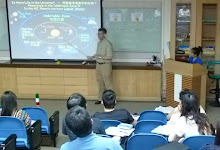As I was peeling a cold papaya a rush of discomfort went through my hand, which got me thinking how might it be a bit of a bad design that mammals have to keep their bodies in such a close temperature range? Why did evolution make our bodies put so much effort into continuously keeping our temperatures constant? Is it really worth all the precision sweating or putting on coats to keep the body's chemical buffering agents in proper balance? Or, might it have been better to have designed more tolerance for temperature changes, given that we live on a planet with frequent changes in temperature? Might dinosaurs have evolve more robust bodies with more temperature change tolerant brains if they had not been replaced by mammals?
Mammals won over dinosaurs, however, so all this mammal design must have virtue. Which brings me to think that I should write about, "What would extraterrestrials look like, if we mean ETs that we find by establishing communication?" Let's call them "smart" extraterrestrials, meaning not like the tiny life that might be found on Mars, or even any fish-like creatures that we can still dream might exist under Europa's ice before better data keeps us from knowing better. I mean like the technological life that could send out radio or similar signals to share some social media banter across the galaxy.
Smart life so defined would most likely have two arms and two legs, I think, if it evolved on land not water, because to build a radio you need two hands with fingers. Perhaps one hand with fingers and two without, like a mini-elephant working equipment with four fingers on a trunk that it props up on two elephant forelegs would do, but then you have the question of whether there would be more fingers on the forelegs, but that might disrupt walking on four legs. Do you really want three arms if you walk upright. But as much as a hand closer to the head would encourage technological development, I do think that two arms and two legs works best. An insect design of six legs seems only to work for insect sizes. No, unless the smart extraterrestrial is underwater so has many arms like a squid, I think two arms and two legs would be best.
What about the many other human features? Evolution seems to have tried fewer fingers and more fingers, but five does seem to work best. Then on to the body: permanent female breasts are apparently mostly on humans, so unless something about doing sex from the front is common, we should consider ET women to usually be flat chested. I suppose a big question would be egg births versus live births using a placenta. Not all ETs might have belly buttons, though that is not significant.
Hair is of course of cosmetic importance. Is there something valuable in having bare skin, such as using skin color to communicate emotion, or just how clothes require less body resources, that would make most ETs largely hairless, with a residual patch on the head (and a few other patches), like us?
Perhaps the design change I would like the most would be found: simple eyes in the back of the head. If you think about all the effort mammalian brains have to put into trying to use hearing coupling with the ability to turn the head, all just to compensate for no vision in back, you would agree that wouldn't it be wonderful to have two, four, or six insect eyes in the back of the head? Simple eyes, like on the head of a bee, could dramatically increase alertness for any mammal, reptile, or bird. Even fish for that matter might benefit if the earliest fish had not gone for just two eyes, though perhaps it was the water environment that limited eyes for all future generations. Simple supplementary eyes would only need to see vague shapes, and could be so small that they could easily be re-grown if injured, and they might dramatically change the full design of other world animals, including our social media ET friends.
So that is it: Regardless of whether ET's hands get chilled by refrigerated fruit, they might look different mostly because they have compound eyes like those of insects in the back of their heads. How wonderful it would be to see all around, even vaguely. The idea may be a fun fancy that cannot be checked by hard data any time soon, with the most immediate use being to design attention-getting Halloween costumes, but it would be fun to anticipate what our descendants might see when they discover our first different part of the galaxy friends. I wonder if after imagining this, if when we first see ET, how much will we be surprised? We may be surprised less than they are. We may find that us humans are more used to surprise than they are, because none of us have eyes in the backs of our heads.
Subscribe to:
Post Comments (Atom)

No comments:
Post a Comment